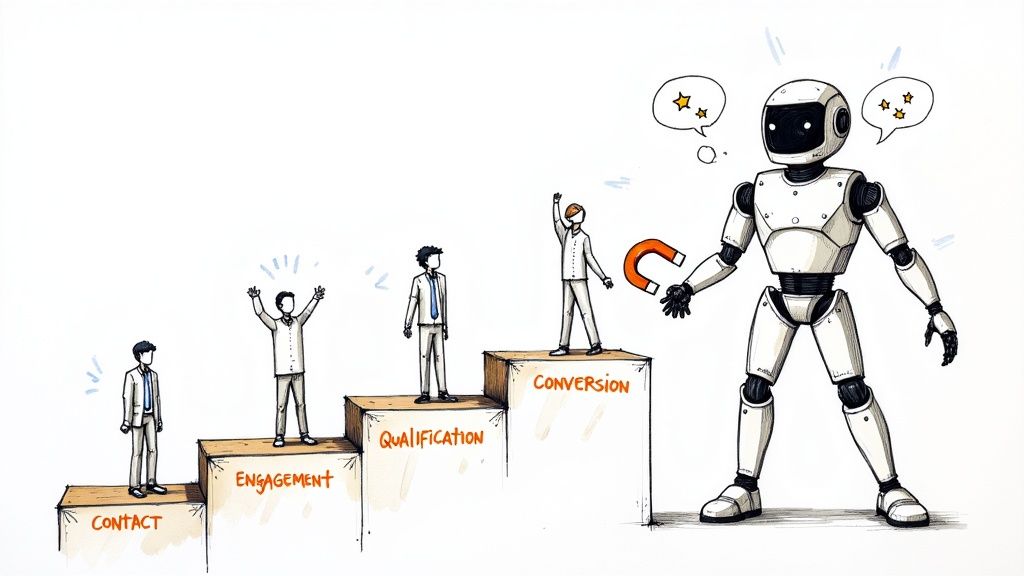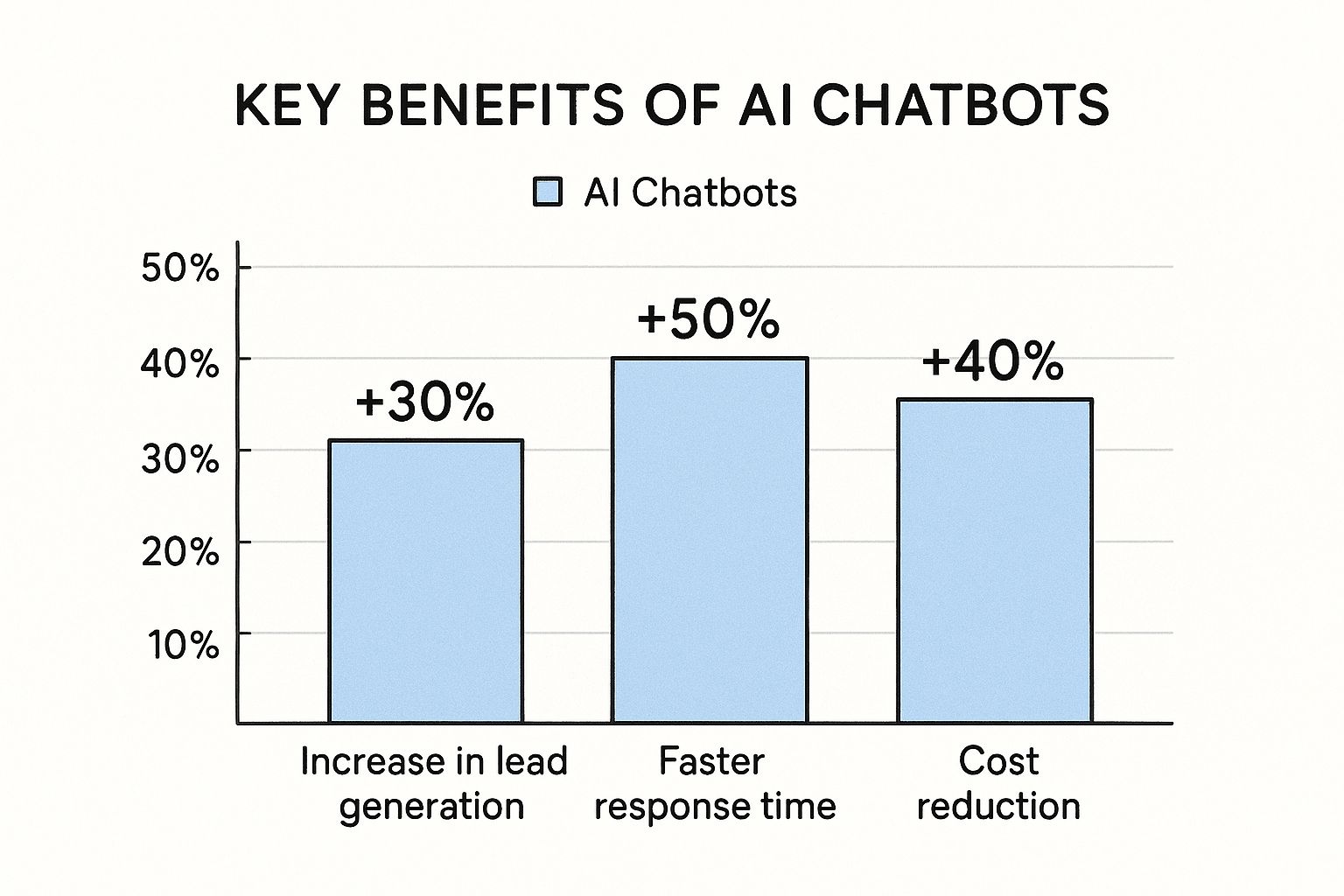
Boost Sales with AI Chatbot for Lead Generation
Why AI Chatbots Are Your New Sales Superpower

This screenshot from Wikipedia shows just how far chatbots have come. They’ve evolved from basic, rule-based systems to the complex, AI-powered conversational agents we see today. This mirrors their growing importance in the business world. It’s a testament to how sophisticated and effective they’ve become at engaging potential customers and driving growth.
Think of it this way: remember those old “message in a bottle” contact forms? You’d fill one out and hope someone, somewhere, would eventually get back to you. An AI chatbot for lead generation is the opposite. It's like having a dedicated receptionist instantly greeting every visitor and guiding them to exactly what they need.
This immediate, personalized interaction changes the game. Imagine a potential customer browsing your website at 2 AM. They're intrigued by your product but not sure where to go next. A static website offers limited help. But an AI chatbot? It can provide instant answers, share helpful resources, and even make personalized recommendations.
Turning Late-Night Browsers into Leads
This means capturing opportunities that would have been lost before. These late-night browsers, the ones with a fleeting interest, are now engaged, nurtured, and converted into valuable leads. It's not just about convenience. It’s about building a smooth and engaging customer experience from the very first interaction.
Studies show people prefer conversational engagement. Let's be honest, filling out forms can be tedious and impersonal. An AI chatbot offers a more dynamic, interactive experience. Lead generation feels less like data entry and more like a conversation.
Boosting Your Bottom Line with Chatbots
This better experience leads to higher conversion rates. In fact, businesses using AI chatbots for lead generation have seen a 67% increase in sales. This is thanks to improved lead generation, qualification, and personalized interactions. This impressive jump shows how effective chatbots are at guiding customers through the sales funnel, especially in areas like eCommerce and SaaS, where conversion rates can reach 70%. Learn more about chatbot effectiveness here.
The real power of AI chatbots lies in building rapport. They can create genuine connections with potential customers. Using natural language processing and sentiment analysis, these digital assistants understand not just what people are saying, but how they’re feeling.
The Human Touch of AI
This lets chatbots tailor their responses, offering empathetic support, proactive guidance, or a gentle nudge towards the next step. This subtle, human touch builds trust and fosters deeper engagement, making interactions feel authentic.
This conversational approach allows for scalable lead generation without a huge increase in costs. Unlike hiring more sales staff, an AI chatbot efficiently handles a high volume of inquiries simultaneously. Every potential customer receives prompt, personalized attention. This frees up your human sales team to close deals and build stronger relationships with high-value prospects. This blend of automation and personalization makes AI chatbots a true sales superpower for modern businesses.
The Numbers That Will Change Your Mind About Chatbots

This infographic paints a picture of how AI chatbots can impact your business. It visually represents potential improvements in lead generation, response time, and cost savings. These aren't just minor tweaks; they represent a fundamental shift in how efficiently you can connect with potential customers and manage your spending. But what's the financial reality behind these changes?
Let's be honest, traditional lead generation can be a financial drain. Consider the salaries of your sales representatives, the expenses of marketing campaigns, and the productivity lost due to slow response times. These costs quickly accumulate. However, businesses using AI chatbots see a significant increase in both the quality and quantity of leads. This boost in efficiency comes from the chatbot's ability to be available 24/7, qualifying leads based on predetermined criteria, and nurturing them through personalized interactions.
Imagine a potential customer visiting your website at 3 AM. Your sales team is sound asleep, but an AI chatbot is there to greet them, answer their questions, and even capture their contact information. This 24/7 availability alone translates to a considerable increase in captured leads.
Real Cost Savings and Faster Sales Cycles
This all leads to tangible cost savings. Companies using platforms like Chatisto are saving thousands of dollars annually by automating tasks previously handled by human sales representatives. This automation allows sales teams to concentrate on what they do best: closing deals.
Moreover, the speed of chatbots drastically reduces sales cycles. Faster response times lead to higher conversion rates, which directly boosts your profits. The growth of the global AI chatbot market underscores this value.
By 2029, the market is projected to reach $46-47 billion, a massive leap from $10-15 billion in 2025. This growth is driven by chatbots' ability to increase sales, improve customer satisfaction, and lower labor costs. In fact, some businesses are saving up to $300,000 per year by implementing chatbots. You can explore more about this burgeoning market here.
To illustrate the financial differences, let's look at a comparison:
To better illustrate the financial implications, let's compare traditional lead generation methods with AI-powered chatbots:
Traditional vs AI Chatbot Lead Generation Costs
| Method | Annual Cost | Response Time | Availability | Conversion Rate |
|---|---|---|---|---|
| Traditional (e.g., Sales Team, Marketing Campaigns) | High (e.g., $100,000+) | Slow (e.g., hours to days) | Limited (e.g., business hours) | Lower (e.g., 2-5%) |
| AI Chatbot | Lower (e.g., $5,000 - $20,000) | Immediate (e.g., seconds) | 24/7 | Higher (e.g., 5-15% or more) |
Note: These figures are estimates and can vary depending on factors like industry, business size, and specific tools used.
This table highlights the key advantages of AI chatbots. The lower annual cost, combined with immediate response times and 24/7 availability, contributes to significantly higher conversion rates. This translates directly into a stronger ROI and a more competitive edge in the market. Businesses clinging to outdated methods are not just missing opportunities; they're falling behind competitors who embrace the power of AI-driven lead generation.
The Must-Have Features That Actually Move The Needle

Let's be honest, not all chatbot features are created equal. Some are just bells and whistles. But a few core capabilities are absolutely essential for a lead-generating AI chatbot. Think of it like a car: sure, heated seats are nice, but the engine and wheels are what really matter.
Natural Language Processing (NLP): The Engine of Understanding
Imagine trying to order a coffee in a foreign country where you don't speak the language. You might point at a menu item, use gestures, and even try a few broken phrases. Now, imagine if the barista could understand your intent despite the communication barriers. That's the power of Natural Language Processing (NLP). NLP helps your chatbot understand the nuances of human language, like slang, typos, and different ways of saying the same thing.
This means your chatbot can figure out what a user means, even if they don’t say it perfectly. Instead of forcing users to type specific commands, NLP lets them communicate naturally. This makes the interaction smoother and more engaging.
Intelligent Conversation Flows: The Steering Wheel of Engagement
A rigid, pre-programmed conversation flow is like following a script. It doesn’t allow for much flexibility. Intelligent conversation flows, on the other hand, adapt to the user's responses in real-time. It’s like having a conversation with a human who can listen and respond appropriately.
If a prospect shows interest in a specific product, the chatbot can provide more details on the spot. If they're not interested, the chatbot can seamlessly shift gears and explore other options. This personalized approach keeps users engaged and increases the chances of capturing their information.
Context Memory: The GPS of Personalization
Have you ever called customer service and had to repeat your entire story to multiple agents? It’s a frustrating experience. Context memory helps avoid this issue with chatbots. By remembering past interactions, the chatbot can provide a more personalized and relevant experience.
For example, if a user previously asked about pricing, the chatbot can greet them on their return with a tailored message referencing their earlier inquiry. This shows you value their time and makes them feel understood.
Smart Routing: The Fast Lane to Conversion
Your AI chatbot isn’t meant to replace your sales team – it’s meant to make them more efficient. Smart routing connects hot prospects with the right sales representatives at the right time. This feature uses criteria, such as lead score or demonstrated interest, to automatically direct qualified leads to the appropriate sales person. It's like having a personal assistant who pre-qualifies leads and schedules meetings. This speeds up the sales process and boosts your conversion rates.
Sentiment Detection and Predictive Lead Scoring: The Turbo Boost
Finally, features like sentiment detection and predictive lead scoring take your chatbot to the next level. Sentiment detection helps the chatbot understand the emotional tone of a conversation. This allows the bot to adjust its approach, offering support or encouragement as needed. Predictive lead scoring analyzes prospect data to identify high-potential leads. This lets you focus your efforts on the prospects most likely to become customers. For a more detailed look at these functionalities, check out Chatisto's AI Chatbot features. These advanced features transform your chatbot from a simple tool into a powerful lead generation machine.
Real Success Stories From Companies Just Like Yours
Forget the theory. Let's dive into how real businesses, just like yours, have used AI chatbots for lead generation and seen amazing results. These aren't just feel-good stories; they're practical examples you can learn from.
From 12 to 200: A SaaS Startup's Chatbot Transformation
Picture a SaaS startup struggling to generate leads, barely scraping together 12 per month. They knew they needed a change but lacked the resources for a huge sales team. Their solution? An AI chatbot.
Instead of hard selling, they programmed their chatbot to offer helpful advice, almost like a consultant. The result? Their monthly leads exploded to over 200 qualified prospects. It wasn't just about quantity; the chatbot also qualified leads, ensuring they were genuinely interested and a good fit for the product. This saved the startup valuable time and resources.
Shortening the Sales Cycle: A B2B Manufacturer's Win
A traditional B2B manufacturer faced a long, drawn-out sales cycle. Prospects hesitated, needing multiple interactions before committing. So, they strategically placed an AI chatbot on their website, catching prospects at the perfect moment – while browsing product pages, comparing features, and actively looking for information.
Instead of passively waiting for prospects to fill out forms during business hours, the chatbot engaged them proactively. The impact? Their sales cycle shrank by a remarkable 45%, leading to faster conversions and a streamlined sales process.
24/7 Lead Capture: An E-commerce Company's Solution
Imagine running an e-commerce business and needing to capture leads around the clock. Hiring a night shift sales team is expensive. This company's solution? An AI chatbot. Their chatbot handled inquiries, answered questions, and collected contact information 24/7. This boosted lead volume and improved customer satisfaction by offering instant support, anytime. This constant availability gave them a real competitive edge and personalized interactions at scale.
Platforms like Intercom show how seamlessly chatbots integrate into websites. A strategically placed chatbot window grabs attention and offers immediate help, demonstrating a focus on customer service and lead generation. This proactive approach helps capture leads that might otherwise slip away.
Learning from the Messy Details
These success stories aren't just about the victories. They also include the bumps in the road: the initial doubts from the sales team, the chatbot conversations that fell flat, and the unexpected discoveries that changed everything. You might find our blog post on lead generation chatbots helpful: learning more about lead generation chatbots in our blog post.
Real-world experiences offer invaluable lessons, highlighting that successful AI chatbots require constant tweaking and adaptation. These stories provide practical takeaways and realistic timelines, helping you set achievable goals for your own chatbot project. They emphasize the importance of a clear strategy, continuous improvement, and focusing on providing value to potential customers.
To give you a more concrete sense of the potential impact, let's look at some industry-specific data.
The table below shows how AI chatbots are performing across various industries, looking at key metrics like conversion rates, lead quality, and ROI timelines.
Industry-Specific Chatbot Performance Metrics
| Industry | Average Conversion Rate | Lead Quality Score | Implementation Timeline | ROI Timeline |
|---|---|---|---|---|
| SaaS | 5% - 15% | 7/10 | 4-8 weeks | 6-12 months |
| E-commerce | 3% - 8% | 6/10 | 2-6 weeks | 3-9 months |
| B2B Manufacturing | 2% - 5% | 8/10 | 6-12 weeks | 9-18 months |
| Healthcare | 1% - 3% | 7/10 | 8-16 weeks | 12-24 months |
These figures, while averages, illustrate the potential of AI chatbots to boost lead generation across different sectors. The variations highlight the importance of tailoring your chatbot strategy to your specific industry and target audience. Remember, a well-defined strategy and continuous optimization are key to maximizing your chatbot's effectiveness and achieving a positive ROI.
Your Step-By-Step Implementation Roadmap
Launching an AI chatbot for lead generation isn't as simple as just plugging it in and watching the magic happen. It's more like planning a cross-country road trip – you need a map, a clear destination, and a well-stocked car. This section lays out a roadmap to guide your chatbot implementation journey and ensure it becomes a valuable part of your lead generation strategy.
Auditing Your Current Lead Generation Process
Before introducing any new tools, it’s essential to understand your existing processes. Imagine a doctor diagnosing a patient – they wouldn’t prescribe medication without first understanding the symptoms. Similarly, you need to diagnose the strengths and weaknesses of your current lead generation process.
- Identify Bottlenecks: Where do leads slow down or disappear in your current system? Are your response times lagging? Are your forms too complicated? Identifying these friction points is key.
- Analyze Lead Quality: Are you attracting the right kind of leads? An AI chatbot can act as a gatekeeper, asking qualifying questions and ensuring your sales team focuses on high-potential prospects. It's like having a pre-screening process for a job interview.
- Assess Resource Allocation: Are your sales reps bogged down by repetitive questions? A chatbot can handle these routine inquiries, freeing up their time for more complex and strategic tasks. Think of it as automating the administrative tasks so your team can focus on building relationships.
Mapping Conversation Flows
Once you understand your current process, you can start designing the chatbot's conversation flows. This is like scripting a play – you need to carefully plan each scene to create a compelling narrative.
- Define Objectives: What’s the chatbot’s purpose? Is it to capture contact info, qualify leads, schedule demos, or something else? Setting clear goals is essential for success.
- Create Natural Conversations: Nobody wants to talk to a robot. Design conversations that feel natural and reflect your brand's personality. Think about how you'd talk to a customer in person and try to replicate that experience.
- Guide Prospects Towards Your Goals: Subtly steer the conversation towards your desired outcomes. This might involve providing helpful information, answering common questions, or offering personalized recommendations. Think of it as gently guiding a customer through a store.
Training Your Chatbot
Just like a new employee, your chatbot needs training. You wouldn't expect someone to perform their job perfectly on their first day, and the same goes for your chatbot.
- Use Real Customer Data: Analyze past customer interactions to understand how they ask questions and express their concerns. This is like giving your chatbot a crash course in customer communication.
- Avoid Corporate Jargon: Customers don't speak the same language as your internal teams. Train your chatbot to use clear, everyday language that resonates with your target audience. Think plain English, not technical jargon.
- Continuous Optimization: Chatbot training is an ongoing process. Regularly review and update its knowledge base to ensure it stays relevant and effective. It's like giving your chatbot regular performance reviews and ongoing professional development.
Managing the Handoff to Your Sales Team
A chatbot isn’t meant to replace your sales team; it's designed to make them more efficient. This requires a smooth handoff process.
- Identify Handoff Triggers: What signals that a prospect needs to speak with a human? This could be based on their lead score, demonstrated interest, or specific questions asked.
- Provide Context: When transferring a lead, ensure the chatbot shares the conversation history with the sales rep. This prevents frustrating repetition for the prospect and allows the rep to personalize their approach.
- Seamless Integration: Integrate your chatbot with your CRM system (like Salesforce). This ensures all lead data is captured and accessible to your sales team, enabling efficient follow-up.
Maintaining Brand Voice Consistency
Your chatbot represents your brand, so maintaining a consistent voice is crucial.
- Define Your Brand Personality: Is your brand friendly, professional, quirky, or something else? Clearly define your brand's personality and communication style.
- Reflect This in Chatbot Language: Ensure your chatbot’s language reflects your brand's personality. This creates a cohesive and consistent experience for your prospects.
Setting Up CRM Integration
Connecting your AI chatbot with your CRM is like creating a central hub for all your lead data. This streamlined approach automatically adds leads to your CRM, saving time and preventing lost opportunities.
Creating Feedback Loops
Constant improvement is key. Set up feedback mechanisms, like analyzing chat logs and gathering customer feedback, to identify areas for improvement. This allows you to fine-tune your chatbot and maximize its performance.
Managing the Transition Period
Introducing a new system requires careful management. Roll out your chatbot gradually, train your team thoroughly, and communicate clearly with customers to ensure a smooth and successful transition.
Measuring What Matters and Maximizing Your Results

This dashboard gives you a glimpse into the data you can collect from your AI chatbot for lead generation. It's more than just counting chats; think of it like reading between the lines of a conversation. These metrics tell a story about how engaged your potential customers are and how well your chatbot is guiding them toward making a purchase.
But how do we actually measure and, more importantly, improve the results we're getting?
Simply counting conversations is like counting how many people walk past your store. It doesn't tell you how many actually came in and bought something. To understand the real value of your AI chatbot, you need a smarter approach. This means tracking the right metrics and using them to constantly tweak and improve your chatbot's performance.
Key Metrics for Chatbot Success
Imagine your chatbot as a member of your sales team. You wouldn't judge a salesperson only on how many calls they make, right? You'd also look at how many of those calls turn into sales, the average value of those sales, and how satisfied their customers are. The same goes for your chatbot.
- Conversation Completion Rate: This tells you how many conversations reach a specific goal, like someone giving you their contact information or booking a demo. A high completion rate means your chatbot is doing a good job of guiding people through the process.
- Engagement Depth: This takes things a step further. It measures how involved people are in the conversation. Are they asking questions? Looking at resources? Checking out products? The more engaged they are, the more likely they are to become a customer.
- Lead Qualification Rate: Not all leads are equal. Some people are just browsing, while others are ready to buy. This metric tracks how many chatbot conversations result in high-quality leads—people who are a good fit for your product or service.
Connecting Interactions to Closed Deals
Tracking these metrics is a great start, but the real goal is to see how these interactions contribute to actual sales. This is where attribution models come in. They help connect the dots between a chatbot conversation and a final purchase.
Let's say someone chats with your bot, then later contacts your sales team and buys something. An attribution model helps you understand how much credit the chatbot deserves for starting that customer journey. This allows you to see the real return on your chatbot investment.
Optimizing for Continuous Improvement
Using data like this lets you constantly improve your chatbot. You can try out different conversation flows (A/B testing) to see what works best. You can also spot red flags that tell you when something needs adjusting, and even optimize for busy seasons. For more on calculating chatbot ROI, take a look at our guide on Chatbot ROI. Plus, analyzing conversation data can give you valuable clues about what prospects are really looking for, helping you refine your strategy and boost those conversion rates.
Reporting Results to Stakeholders
Finally, you need to show the value of your AI chatbot to the people who matter. This means presenting your results in a way that clearly demonstrates the return on investment. Show them how the chatbot is impacting revenue directly and also how it's saving money behind the scenes (like reducing the workload on your customer service team). By showcasing the chatbot's contribution to the bottom line, you can justify continued investment and ensure its long-term success.
Future-Proofing Your Lead Generation Strategy
The world of AI chatbots for lead generation is constantly changing. To stay ahead, you need to anticipate what’s next. Think of it like navigating a ship – you need to constantly adjust your course based on the currents and weather to reach your destination. This section explores the emerging trends shaping the future of lead generation.
The Rise of Conversational AI
Forget clunky typed interactions. Voice AI integration is making chatbot conversations more natural. Imagine chatting with a chatbot just like you would a colleague, using your voice. This shift towards voice interaction humanizes the lead generation process, making it feel more like a helpful conversation than filling out a form.
Predictive analytics are also transforming the landscape. These tools allow for proactive lead engagement, connecting with potential customers before they even know they need your product or service. It's like having a mind-reading salesperson who anticipates customer needs. This proactive approach can significantly boost lead capture and foster stronger customer relationships.
And then there's emotional intelligence. Chatbots are getting better at understanding and responding to human emotions, creating more genuine and empathetic interactions. Think of a chatbot that senses frustration and offers personalized support. This builds trust and deepens customer connections.
This screenshot from OpenAI’s ChatGPT page demonstrates the power of conversational AI. The simple interface and natural language interaction highlight how user-friendly and human-like AI conversations are becoming, reflecting the broader trend towards more human-centered AI experiences.
Breakthrough Technologies on the Horizon
The future of AI chatbots for lead generation is brimming with potential. Visual recognition technology, for example, could allow chatbots to suggest products based on images. A customer shares a photo of a broken appliance, and the chatbot instantly identifies the correct replacement part.
Multilingual capabilities are also breaking down barriers, allowing businesses to connect with potential leads worldwide without needing large international teams. This opens up a wealth of new lead generation opportunities in global markets.
Finally, advanced personalization engines can create truly individual experiences for each website visitor based on their specific behavior. This goes far beyond simply using a customer's name. Imagine providing perfectly tailored content, recommendations, and solutions. This highly personalized approach can significantly improve engagement and drive conversions.
Ethical Considerations in the Age of AI
As AI becomes more advanced, ethical considerations are crucial. Data privacy is paramount. Chatbots collect significant amounts of data, so handling this information responsibly and transparently is essential. Customers need to understand how their data is used and have confidence that it's being protected.
Transparency in AI interactions is also key. Customers should always know if they’re interacting with a bot or a human. This builds trust and prevents any sense of misrepresentation. Open and honest communication is the foundation of any strong customer relationship.
In our increasingly tech-driven world, addressing these ethical considerations will be vital for building trust and creating a sustainable future for AI-powered lead generation. Keeping up with these evolving trends and adapting your strategies accordingly will be critical for long-term success.
Ready to see how AI can transform your lead generation? Discover how Chatisto can help you capture more leads, qualify prospects, and boost conversions.
Table of Contents
- Turning Late-Night Browsers into Leads
- Boosting Your Bottom Line with Chatbots
- The Human Touch of AI
- The Numbers That Will Change Your Mind About Chatbots
- The Must-Have Features That Actually Move The Needle
- Real Success Stories From Companies Just Like Yours
- Your Step-By-Step Implementation Roadmap
- Measuring What Matters and Maximizing Your Results
- Future-Proofing Your Lead Generation Strategy